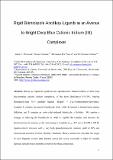Rigid biimidazole ancillary ligands as an avenue to bright deep blue cationic iridium(III) complexes
Abstract
Herein we report the synthesis and optoelectronic characterisation of three deep blue-emitting cationic iridium complexes, of the form [Ir(dFppy)2(N^N)]PF6, bearing biimidazole-type N^N ancillary ligands (dFppyH = 2-(2,4-difluorophenyl)pyridine). Complex 1 contains the parent biimidazole, biim, while 2 contains a dimethylated analog, dMebiim, and 3 contains an ortho-xylyl-tethered biimidzole, o-xylbiim. We explore a strategy of tethering the biimidazole in order to rigidify the complex and increase the photoluminescent quantum yield, culminating in deep blue (λmax: 457 nm in MeOH at 298 K) ligand-centered emission with a very high photoluminescent quantum yield of 68% and microsecond emission lifetime. Density functional theory calculations elucidate the origin of such disparate excited state kinetics across this series, especially in light of virtually identical optoelectronic properties observed for these compounds.
Citation
Henwood , A F , Evariste , S , Slawin , A M Z & Zysman-Colman , E 2014 , ' Rigid biimidazole ancillary ligands as an avenue to bright deep blue cationic iridium(III) complexes ' , Faraday Discussions , vol. 174 , pp. 165-182 . https://doi.org/10.1039/C4FD00107A
Publication
Faraday Discussions
Status
Peer reviewed
ISSN
1359-6640Type
Journal article
Description
EZ-C acknowledges the University of St Andrews for financial support. Date of Acceptance: 03/06/2014Collections
Items in the St Andrews Research Repository are protected by copyright, with all rights reserved, unless otherwise indicated.

